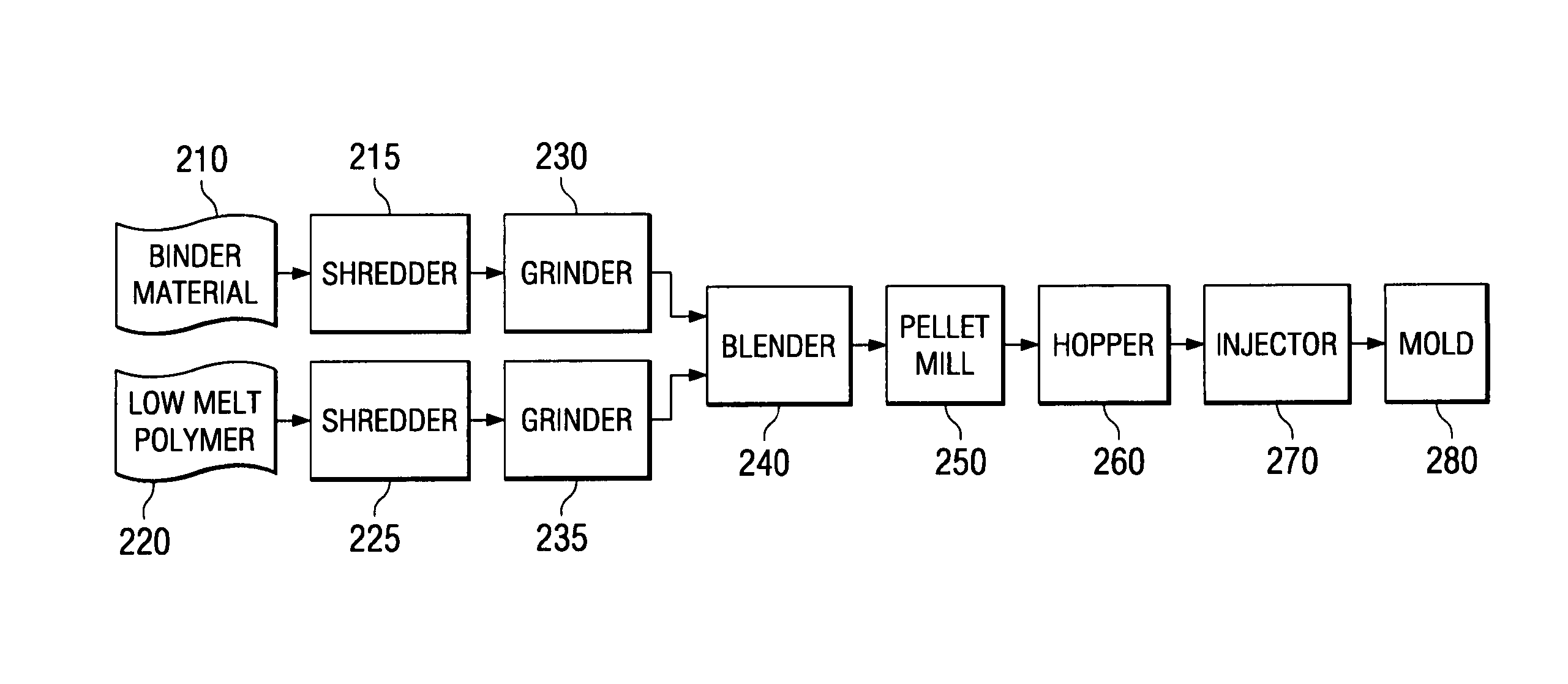Process for recycling fiber material and binder with novel injection mold and parts made thereby
- Summary
- Abstract
- Description
- Claims
- Application Information
AI Technical Summary
Benefits of technology
Problems solved by technology
Method used
Image
Examples
example 1
[0106] The raw materials for the final product are waste poly propylene carpet having a glue resin backing of polyolefin and polypropylene agricultural film. Approximately 180 pounds of carpet was cut by hand into 1″ or 2″ pieces. The pieces are fed into a laboratory size Cumberland grinder at a rate of 5 to 10 pounds per hour. Grinding was continued for approximately one minute or until a particle size of between ⅛″ and ¼″ was reached. Particles exit a ¼″ screen from the grinder. There were individual fiber lengths that may be longer than 1 / 4″ and some particle sizes may be less that ⅛″. The temperature of the material exiting the grinder was approximately 125° F.
[0107] Approximately 120 pounds agricultural film was cut by hand into 1″ or 2″ pieces. The pieces were then fed into a laboratory-size Cumberland grinder. The grinding was done using a ¼″ screen to produce an average particle size of between ⅛″ and ¼″. The material was ground a short period of time, approximately 1 minut...
example 2
[0117] In this next example, remnants from diaper production were added to the carpet and agricultural film. The carpet and agricultural film were ground as discussed in Example 1. Further 80 pounds of diapers were cut by hand into 1″ to 2″ pieces that were then fed into the grinder. The material was ground at a rate of 5 to 10 pounds per hour. The grinder used was a Cumberland grinder. The grinder was fitted with a ¼″ screen and produced an average particle size of between ⅛″ and ¼″ in length. The material was ground for approximately 1 minute. The temperature of the material exiting the grinder was slightly elevated due to the shear energy during the grinding.
[0118] The ground diapers, ground carpet, and ground agricultural film were fed simultaneously into a blender. The ratio of diapers to agricultural film was 40% diapers, 40% carpet, and 20% agricultural film by weight. The material included 80 pounds of ground diaper, 80 pounds of ground carpet, and 40 pounds of ground agric...
example 3
[0127] In this example, the materials are post consumer plastics, specifically plastic bottles manufactured from polyethylene (HDPE) and polyethylene terephthalate (PET), as the raw materials.
[0128] 20 pounds of PET was cut into 1″ or 2″ pieces and then fed into a
[0129] Cumberland grinder with a screen size of ¼″. The PET is ground at a rate of 5 to 10 pounds per hour. The particles upon leaving the grinder were an average of between ⅛″ and ¼″ in length.
[0130] About 30 pounds of HDPE was cut into 1″ or 2″ pieces. The HDPE was fed into a grinder at the rate of approximately 5 to 10 pounds per hour. A ¼″ screen on the grinder produces an average particle size of between ⅛″ and ¼″ in length in approximately 1 minute. The temperature of the material exiting the grinder was approximately 200° F.
[0131] The ground PET and HDPE were fed into a blender at a ratio of 40 / 60 of PET to HDPE by weight. The blending pieces formed approximately 50 pounds of PET and HDPE mixture.
[0132] The blen...
PUM
| Property | Measurement | Unit |
|---|---|---|
| Temperature | aaaaa | aaaaa |
| Fraction | aaaaa | aaaaa |
| Fraction | aaaaa | aaaaa |
Abstract
Description
Claims
Application Information
 Login to View More
Login to View More - R&D
- Intellectual Property
- Life Sciences
- Materials
- Tech Scout
- Unparalleled Data Quality
- Higher Quality Content
- 60% Fewer Hallucinations
Browse by: Latest US Patents, China's latest patents, Technical Efficacy Thesaurus, Application Domain, Technology Topic, Popular Technical Reports.
© 2025 PatSnap. All rights reserved.Legal|Privacy policy|Modern Slavery Act Transparency Statement|Sitemap|About US| Contact US: help@patsnap.com



